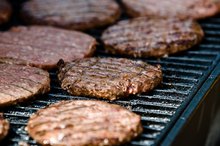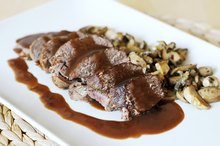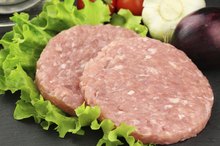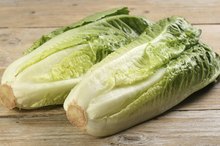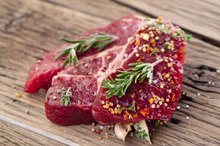What does fact checked mean?
At Healthfully, we strive to deliver objective content that is accurate and up-to-date. Our team periodically reviews articles in order to ensure content quality. The sources cited below consist of evidence from peer-reviewed journals, prominent medical organizations, academic associations, and government data.
The information contained on this site is for informational purposes only, and should not be used as a substitute for the advice of a professional health care provider. Please check with the appropriate physician regarding health questions and concerns. Although we strive to deliver accurate and up-to-date information, no guarantee to that effect is made.
Unless you hunt, you may have never eaten elk. Hunters use the meat for steaks, sausage and ground meat patties. Although rarely seen at the meat market, ground elk is an alternative for ground beef or turkey in recipes. Ground elk lower in fat and higher in protein than either of these meats, making it a healthier alternative for burgers, as well.
Calories
A 3-oz. serving of ground elk meat contains 164 calories, which is slightly fewer calories than a similar serving of 90 percent lean ground beef or 93 percent lean ground turkey. Like ground beef and ground turkey, elk meat contains no carbohydrates, so all of the calories in each serving come from protein and fat.
Protein
The Nutritional Values of Freshwater Fish
Learn More
Three oz. of ground elk contain 22.6 g of protein, which is 49 percent of the dietary reference intake--the recommended daily amount--for women. One serving provides 40 percent the dietary reference intake of protein for men. This is slightly more protein than either ground beef or ground turkey, which contain 21.4 g and 22 g per serving, respectively.
- of ground elk contain 22.6 g of protein, which is 49 percent of the dietary reference intake--the recommended daily amount--for women.
Fat
One serving of ground elk contains 7.4 g of fat, which is lower than both ground beef and ground turkey. Ground beef contains 9.1 g of fat, and ground turkey contains 9.7 g. Ground turkey is lower in saturated fat, though, with only 2.5 g, compared with 3.4 g. for ground elk. However, ground elk is lower in cholesterol than ground turkey, with 66 mg of fat per serving, compared with 90 mg per serving for ground turkey. Because high cholesterol foods can lead to heart disease, you should limit your intake to 300 mg or less per day.
- One serving of ground elk contains 7.4 g of fat, which is lower than both ground beef and ground turkey.
- However, ground elk is lower in cholesterol than ground turkey, with 66 mg of fat per serving, compared with 90 mg per serving for ground turkey.
Minerals
Lamb Shank Nutrition
Learn More
Elk meat is similar to ground beef in mineral content, with both types of meat providing significant amounts of iron, potassium and zinc. One serving of ground elk supplies 36 percent of the daily recommended intake of iron for men and 16 percent for women, while ground beef supplies 29 percent for men and 13 percent for women. Both meats provide 15 percent of the daily recommended intake of potassium and more than 48 percent of zinc. Ground turkey provides less of all three minerals, especially iron, for which one serving provides only 8 percent for women and 18 percent for men.
- Elk meat is similar to ground beef in mineral content, with both types of meat providing significant amounts of iron, potassium and zinc.
Vitamins
Although low in vitamin C, ground elk contains large amounts of many B vitamins 1. One serving supplies 18 percent of the daily recommended intake of pantothenic acid, 28 percent of B-6, 91 percent of B-12 and more than 20 percent of both niacin and riboflavin. All B vitamins assist with metabolism and red blood cell formation 1. Ground beef contains similar amounts of niacin, B-6 and B-12, but is lower in both riboflavin and pantothenic acid than elk. Turkey is lower in riboflavin and B-12 than elk, but similar in other B vitamins 1.
Related Articles
References
- MedlinePlus: B Vitamins
- Center for Nutrition Policy and Promotion: Nutritional Goals
- Beef, ground, 85% lean meat / 15% fat, crumbles, cooked, pan-browned. FoodData Central. U.S. Department of Agriculture. Published April 1, 2019.
- US Department of Agriculture. MyPlate: Nutrients and health benefits.
- Clifford J, Curely J. Water-soluble vitamins: B-complex and vitamin C. Colorado State University Extension. Updated December 2019.
- National Institutes of Health Office of Dietary Supplements. Iron: Fact sheet for health professionals. Updated February 28, 2020.
- American College of Allergy, Asthma and Immunology. Meat allergy. Updated May 8, 2019.
- Song M, Garrett WS, Chan AT. Nutrients, foods, and colorectal cancer prevention. Gastroenterology. 2015;148(6):1244-60.e16. doi:10.1053/j.gastro.2014.12.035
- Wolk A. Potential health hazards of eating red meat. J Intern Med. 2017;281(2):106-122. doi:10.1111/joim.12543
- Daley CA, Abbott A, Doyle PS, Nader GA, Larson S. A review of fatty acid profiles and antioxidant content in grass-fed and grain-fed beef. Nutr J. 2010;9:10. doi:10.1186/1475-2891-9-10
Writer Bio
Lisa Thompson has been writing since 2008, when she began writing for the Prevention website. She is a holistic health practitioner, nationally certified massage therapist and National Council on Strength and Fitness-certified personal trainer. Thompson also holds certificates in nutrition and herbology from the Natural Healing Institute, as well as a Master of Education from California State University.


